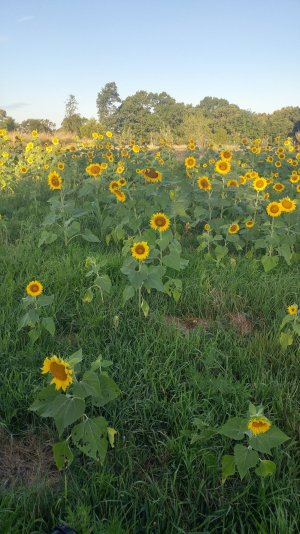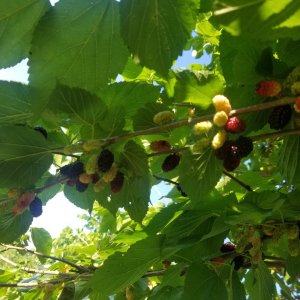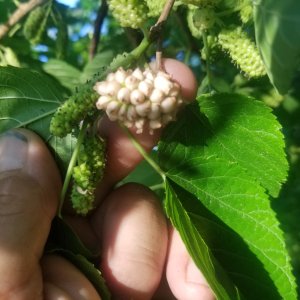-
If you are posting pictures, and they aren't posting in the correct orientation, please flush your browser cache and try again.
Edge
Safari/iOS
Chrome
You are using an out of date browser. It may not display this or other websites correctly.
You should upgrade or use an alternative browser.
You should upgrade or use an alternative browser.
Illinois Ever Bearing Mulberry
- Thread starter b116757
- Start date
Native Hunter
5 year old buck +
It's extremely easy to get the scions to take with bark grafting, and you won't believe how much they can grow the first season. However, be sure to brace the grafts to prevent wind breakage the first year. They seem more susceptible to it than apples, pears or persimmons.
Native Hunter
5 year old buck +
They are interchangeable.Can red and white mulberry's be grafted interchangeably? Or do reds need to be grafted to reds, etc?
paleopoint
5 year old buck +
Here is one narrow view.....if it is even a "view".
It is my singular experience with one Illinois EverBearing.
Which, before I cut it down last summer came to be called 'NeverBearing'.
I planted one in about 2007, if memory serves, and I thought I had hit a home-run.
Growth in that first year was fantastic. So was year two. And three. The best vertical growth I had ever experienced in a young tree.
That sucker was on steroids.
But, it never.....ever....produced one single berry. From 2007 to 2022.....not a one.
Now, I have probably a dozen+ other red mulberries on my farm....purchased either from Coldstream Farm in Michigan, or grown from seeds that I have collected and propagated. Those that are bearing.....are really really bearing. I get lots of fruit from them. Or rather the birds & raccoons do. But not all of 'em. Some never produce because, as I've learned.....they are males. And males don't fruit.
Which must be (?) why my Illinois Everbearing never bore.
It is my singular experience with one Illinois EverBearing.
Which, before I cut it down last summer came to be called 'NeverBearing'.
I planted one in about 2007, if memory serves, and I thought I had hit a home-run.
Growth in that first year was fantastic. So was year two. And three. The best vertical growth I had ever experienced in a young tree.
That sucker was on steroids.
But, it never.....ever....produced one single berry. From 2007 to 2022.....not a one.
Now, I have probably a dozen+ other red mulberries on my farm....purchased either from Coldstream Farm in Michigan, or grown from seeds that I have collected and propagated. Those that are bearing.....are really really bearing. I get lots of fruit from them. Or rather the birds & raccoons do. But not all of 'em. Some never produce because, as I've learned.....they are males. And males don't fruit.
Which must be (?) why my Illinois Everbearing never bore.
Native Hunter
5 year old buck +
Illinois Everbearing is not a species that can be male or female. It is a selected cultivar of a special female tree found growing in the wild. A true Illinois Everbearing cannot be a male, because it must come from scions that directly or indirectly come from the original female tree. IE is suspected to be a cross between a red and white mulberry. This is what I believe as well, because it has characteristics of both.
The positives of this cultivar are:
* The taste is excellent and rated by some as the best of all mulberries.
* The size is large.
* The most unique trait is what gives it the name "Everbearing." It bears 4 times longer than any of the native red mulberries I have ever seen. Weeks after those trees are finished bearing, IE will still be cranking out the fruit. It's not unusual to see three colors of fruit on the tree at one time: Black is ripe, Red will be ripe soon, and the Green ones are still a long way from ripening. Truly a prolific tree.
The positives of this cultivar are:
* The taste is excellent and rated by some as the best of all mulberries.
* The size is large.
* The most unique trait is what gives it the name "Everbearing." It bears 4 times longer than any of the native red mulberries I have ever seen. Weeks after those trees are finished bearing, IE will still be cranking out the fruit. It's not unusual to see three colors of fruit on the tree at one time: Black is ripe, Red will be ripe soon, and the Green ones are still a long way from ripening. Truly a prolific tree.
I am away from ag, I have a medium size mulberry in the fencerow right behind the house. When the leaves start to drop in late Oct every doe and fawn in the neighborhood will scarf up the leaves like crack. The only thing they will pass them up for is corn and sunflowers
Last edited:
Bowsnbucks
5 year old buck +
You had better luck with yours than we did ours at camp. They look good, Mozark!!Edit: not picture worthy and I was only able to grow them once
I never knew the history / source of IE mulberry. Thanks for the info, Native!!!Illinois Everbearing is not a species that can be male or female. It is a selected cultivar of a special female tree found growing in the wild. A true Illinois Everbearing cannot be a male, because it must come from scions that directly or indirectly come from the original female tree. IE is suspected to be a cross between a red and white mulberry. This is what I believe as well, because it has characteristics of both.
blueKYstream
5 year old buck +
Do you ever see Popcorn Disease on Illinois Everbearing @Native Hunter ? Supposedly it is quite susceptible to this fungal disease in the south east (depends on weather at the time of bloom). White mulberries in particular are susceptible to Popcorn Disease from what I read where red mulberries are not. Hybrids of course vary.
I'm debating whether to get some scions to try rooting but dont want to get it if its an issue here. I have several white mulberries growing over my fence in the backyard my neighbors wouldn't care if I grafted as an alternative.
I'm debating whether to get some scions to try rooting but dont want to get it if its an issue here. I have several white mulberries growing over my fence in the backyard my neighbors wouldn't care if I grafted as an alternative.
Native Hunter
5 year old buck +
No, I've not seen it on mine.Do you ever see Popcorn Disease on Illinois Everbearing @Native Hunter ? Supposedly it is quite susceptible to this fungal disease in the south east (depends on weather at the time of bloom). White mulberries in particular are susceptible to Popcorn Disease from what I read where red mulberries are not. Hybrids of course vary.
I'm debating whether to get some scions to try rooting but dont want to get it if its an issue here. I have several white mulberries growing over my fence in the backyard my neighbors wouldn't care if I grafted as an alternative.
Went a number of years without Popcorn Disease showing itself, but once it arrived here, the Illinois Everbearing trees here are badly affected... routinely lose most of the first flush of fruit to Popcorn DZ, but later flushes are less affected.
Silk Hope, Lawson Dawson, Collier, Stearns, Hicks Everbearing, Orlinda, and 'Corral'(my own selection, a seedling of IE) are all M.rubraXalba hybrids, but to date, I have not had issues with Popcorn Disease affecting them. Have a couple of local M.rubra selections grafted in the orchard, and as others have stated, productivity on IE and the other hybrids vastly surpasses the natives - I usually get 6-8 weeks of fruit production from the hybrids.
I've had no success rooting dormant-collected cuttings of mulberry - but I don't have a heated propagation mat or mist system.
I have had some success rooting midsummer semi-hardwood cutting, with minimal TLC.
Bark grafts with dormant scions or mid- to late-summer T-budding onto seedling rootstocks works best for me.
Silk Hope, Lawson Dawson, Collier, Stearns, Hicks Everbearing, Orlinda, and 'Corral'(my own selection, a seedling of IE) are all M.rubraXalba hybrids, but to date, I have not had issues with Popcorn Disease affecting them. Have a couple of local M.rubra selections grafted in the orchard, and as others have stated, productivity on IE and the other hybrids vastly surpasses the natives - I usually get 6-8 weeks of fruit production from the hybrids.
I've had no success rooting dormant-collected cuttings of mulberry - but I don't have a heated propagation mat or mist system.
I have had some success rooting midsummer semi-hardwood cutting, with minimal TLC.
Bark grafts with dormant scions or mid- to late-summer T-budding onto seedling rootstocks works best for me.
blueKYstream
5 year old buck +
How do those Illinois Everbearing alternatives you mention taste? I have some morus alba rootstock growing in my backyard I want to graft to once i get some scions. I might try to grow some of the cuttings (either the alba or scions) for habitat too if it works out.Went a number of years without Popcorn Disease showing itself, but once it arrived here, the Illinois Everbearing trees here are badly affected... routinely lose most of the first flush of fruit to Popcorn DZ, but later flushes are less affected.
Silk Hope, Lawson Dawson, Collier, Stearns, Hicks Everbearing, Orlinda, and 'Corral'(my own selection, a seedling of IE) are all M.rubraXalba hybrids, but to date, I have not had issues with Popcorn Disease affecting them. Have a couple of local M.rubra selections grafted in the orchard, and as others have stated, productivity on IE and the other hybrids vastly surpasses the natives - I usually get 6-8 weeks of fruit production from the hybrids.
I've had no success rooting dormant-collected cuttings of mulberry - but I don't have a heated propagation mat or mist system.
I have had some success rooting midsummer semi-hardwood cutting, with minimal TLC.
Bark grafts with dormant scions or mid- to late-summer T-budding onto seedling rootstocks works best for me.
Those mentioned are all good. Silk Hope is my personal favorite; big, juicy, tasty. 'Corral' is almost indistinguishable from IE. 'Lawson Dawson', which originated 10 miles from here, has performed well in the Northeast/New England. Hicks Everbearing has not fruited (well, it had a few berries last year, but birds beat me to them), but it was a farmstead staple for hogs/chickens, across The South since pre-Civil War days.
I've observed that mulberries that have cows/horses lounging/peeing/pooping beneath them produce larger, tastier fruits than the same cultivar planted in the yard or orchard, without the benefit of 'organic fertilizer'. IDK if granular fert will provide the same, but I'm gonna fertilize the LD tree in the yard this spring, and see how its production matches the two LD trees in the barnyard.
About 10 years ago, I bought a bundle of 100 'Red Mulberry' seedlings from the KY Div. of Forestry Nursery, and planted them along fencelines in the pasture. There is not a single M.rubra in the bunch, and discussion I had last January with our local state forester, revealed that HE was responsible for sourcing mulberry seed for the nursery, and he just gathered fruits from any fruiting mulberry he could find. So... all the 'Red Mulberry' they've been distributing are hybrids, with many in my batch looking like they may even be backcrossed to M.alba again.... many have that 'trashy' M.alba type of growth, glossy leaves, etc.
Some of the females are very productive, but I've not yet found one with the good flavor of Illinois Everbearing or any other named cultivar I've had the chance to sample.
Photo of 'Lawson Dawson' second flush of fruit
I've observed that mulberries that have cows/horses lounging/peeing/pooping beneath them produce larger, tastier fruits than the same cultivar planted in the yard or orchard, without the benefit of 'organic fertilizer'. IDK if granular fert will provide the same, but I'm gonna fertilize the LD tree in the yard this spring, and see how its production matches the two LD trees in the barnyard.
About 10 years ago, I bought a bundle of 100 'Red Mulberry' seedlings from the KY Div. of Forestry Nursery, and planted them along fencelines in the pasture. There is not a single M.rubra in the bunch, and discussion I had last January with our local state forester, revealed that HE was responsible for sourcing mulberry seed for the nursery, and he just gathered fruits from any fruiting mulberry he could find. So... all the 'Red Mulberry' they've been distributing are hybrids, with many in my batch looking like they may even be backcrossed to M.alba again.... many have that 'trashy' M.alba type of growth, glossy leaves, etc.
Some of the females are very productive, but I've not yet found one with the good flavor of Illinois Everbearing or any other named cultivar I've had the chance to sample.
Photo of 'Lawson Dawson' second flush of fruit
Attachments
Last edited:
Similar threads
- Replies
- 8
- Views
- 1K



